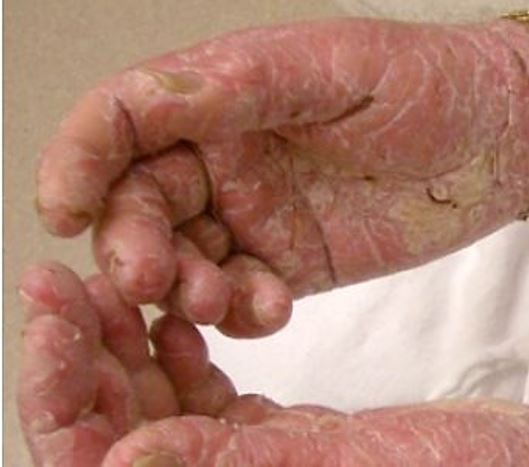- Clinical Technology
- Adult Immunization
- Hepatology
- Pediatric Immunization
- Screening
- Psychiatry
- Allergy
- Women's Health
- Cardiology
- Pediatrics
- Dermatology
- Endocrinology
- Pain Management
- Gastroenterology
- Infectious Disease
- Obesity Medicine
- Rheumatology
- Nephrology
- Neurology
- Pulmonology
Severe Drug Rash in the ED
Patient claims pruritic full-body rash is from a course of vancomycin. Is he correct? Could it be something else?
Severely pruritic rash seen on a A 60-year-old man with a history of HIV. Click to enlarge

A 60-year-old man with a history of HIV presents to the emergency department with an allergic reaction (see Image; click to enlarge) to oral vancomycin which he has been taking for about 1 week for Clostridium difficile colitis. His other medications include nevirapine (Viramune) and abacavir/lamivudine (Epzicom), both of which he has been taking for years, but had stopped temporarily prior to restarting them about a month ago.
He says the rash is itchy more than painful and denies fever, weakness, or any shortness of breath. His only other symptom is the ongoing diarrhea, which has slowed down a little since starting the vancomycin. It is watery, without blood, and occurs 5-10 times a day. His states that his T-cell count was >400 last week.
On exam, vital signs are all within normal limits. His eyes and oropharynx are both clear and the neck is without adenopathy. His lungs are clear and his abdomen benign. Skin findings are impressive with the rash affecting his entire body. (Image below).
Results of a complete blood count, metabolic panel, and liver function tests are all essentially normal.
What is the most likely diagnosis? How woul you treat the patient?
Bonus Question: What other condition(s) should you consider in the presence of diarrhea and rash?
Answer: Erythroderma from allergic reaction to nevirapine
Discussion
Erythroderma, also known as exfoliative dermatitis, is an inflammatory skin condition that causes a red, thick, scaly rash affecting a large body surface area, usually >90% of the total body surface area. Fever may or may not be present and should raise suspicion for the possibility of secondary infection. The most common causes of erythroderma are eczema, psoriasis and other skin conditions, lymphoma and other malignancies, and medications, especially antibiotics, seizure medications, and allopurinol. Nevirapine (Viramune) is infamous for causing erythroderma, even in someone who has tolerated it in the past.
Testing should include blood cultures if fever is present, CBC, metabolic panel, and liver function tests. The differential diagnosis of fever and rash is broad but with such a large surface area involved, some of the top considerations should be toxic shock syndrome and DRESS (drug reaction with eosinophilia and systemic symptoms).
Treatment for erythroderma is primarily supportive unless complications occur. Although the skin is not blistered as in toxic epidermal necrolysis, it is still compromised and the patient usually requires therapy that is similar to that for a burn, including aggressive IV fluids. If erythroderma is suspected to be secondary to a medication, it should obviously be stopped and steroids considered. If the cause is thought to be a medical condition, it should be treated. When there is fever or infection is suspected, appropriate antibiotics should be started. Rarely excessive blood flow to the skin can lead to high output heart failure.
Bonus Answer: Diarrhea and rash presenting together should also make you consider parasite infections, viral illnesses (usually in kids) or Pellegra (niacin deficiency) especially if dementia is also present.
________________________________________________________________
Additional reading
Borrás-Blasco J, Navarro-Ruiz A, Borrás C, Casterá E. Adverse cutaneous reactions associated with the newest antiretroviral drugs in patients with human immunodeficiency virus infection. J ntimicrob Chem. 2008;62:879–888.
Anoosha P. Bhandarkar AP, Kop PK, Pai VV. Nevirapine induced exfoliative dermatitis in an HIV-infected patient. Indian J Pharmacol. 2011;43:738–739. doi: 10.4103/0253-7613.89842
